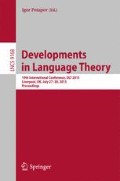Abstract
We obtain results within the area of dense completeness, which describes a close relation between families of formal languages and complexity classes. Previously we were able show that this relation exists between counter languages and \(\mathbf {NL}\) but not between the regular languages and \(\mathbf {NC^1}\).
We narrow the gap between the regular languages and the counter languages by considering visibly counter languages. It turns out that they are not densely complete for \(\mathbf {NC^1}\). At the same time we found a restricted counter automaton model which is densely complete for \(\mathbf {NL}\).
Besides counter automata we show more positive examples in terms of L-systems.
Access this chapter
Tax calculation will be finalised at checkout
Purchases are for personal use only
Preview
Unable to display preview. Download preview PDF.
References
Alur, R., Madhusudan, P.: Visibly pushdown languages. In: Babai, L. (ed.) Proceedings of the 36th Annual ACM Symposium on Theory of Computing, June 13–16, pp. 202–211. ACM, Chicago (2004)
Barrington, D.A.M., Compton, K.J., Straubing, H., Thérien, D.: Regular Languages in NC\({^1}\). J. Comput. Syst. Sci. 44(3), 478–499 (1992)
Bárány, V., Löding, C., Serre, O.: Regularity problems for visibly pushdown languages. In: Durand, B., Thomas, W. (eds.) STACS 2006. LNCS, vol. 3884, pp. 420–431. Springer, Heidelberg (2006)
Dymond, P.W.: Input-Driven Languages are in log n Depth. Inf. Process. Lett. 26(5), 247–250 (1988)
Furst, M.L., Saxe, J.B., Sipser, M.: Parity, Circuits, and the Polynomial-Time Hierarchy. Mathematical Systems Theory 17(1), 13–27 (1984)
Håstad, J.: Almost optimal lower bounds for small depth circuits. In: Hartmanis, J. (ed.) Proceedings of the 18th Annual ACM Symposium on Theory of Computing, May 28–30, pp. 6–20. ACM, Berkeley (1986)
Krebs, A., Lange, K.-J.: Dense completeness. In: Yen, H.-C., Ibarra, O.H. (eds.) DLT 2012. LNCS, vol. 7410, pp. 178–189. Springer, Heidelberg (2012)
Krebs, A., Lange, K.-L., Ludwig, M.: Visibly counter languages and constant depth circuits. In: Mayr, E.W., Ollinger, N. (eds) 32nd International Symposium on Theoretical Aspects of Computer Science, STACS 2015, March 4–7. LIPIcs, vol. 30, pp. 594–607. Schloss Dagstuhl - Leibniz-Zentrum fuer Informatik, Garching (2015)
Mehlhorn, K.: Pebbling moutain ranges and its application of DCFL-Recognition. In: de Bakker, J.W., van Leeuwen, J. (eds) Proceedings of the Automata, Languages and Programming, 7th Colloquium, Noordweijkerhout, July 14–18, The Netherland. LNCS, vol. 85, pp. 422–435. Springer, Heidelberg (1980)
Rozenberg, G., Salomaa, A.: Mathematical Theory of L Systems. Academic Press Inc., Orlando (1980)
Smolensky, R.: Algebraic methods in the theory of lower bounds for boolean circuit complexity. In: Aho, A.V. (ed.) Proceedings of the 19th Annual ACM Symposium on Theory of Computing, pp. 77–82. ACM, New York (1987)
van Leeuwen, J.: The Membership Question for ET0L-Languages is Polynomially Complete. Inf. Process. Lett. 3(5), 138–143 (1975)
van Leeuwen, J.: Variations of a new machine model. In: 17th Annual Symposium on Foundations of Computer Science, October 25–27, pp. 228–235. IEEE Computer Society, Texas (1976)
Vollmer, H.: The gap-language-technique revisited. In: Börger, E., Böuning, H.K., Richter, M.M., Schönfeld, W. (eds) CSL 1990. LNCS, vol. 533, pp. 389–399. Springer, Heidelberg (1990)
Vollmer, H.: Introduction to circuit complexity - a uniform approach. Texts in theoretical computer science. Springer (1999)
Author information
Authors and Affiliations
Corresponding author
Editor information
Editors and Affiliations
Rights and permissions
Copyright information
© 2015 Springer International Publishing Switzerland
About this paper
Cite this paper
Krebs, A., Lange, KJ., Ludwig, M. (2015). On Distinguishing NC\(^1\) and NL. In: Potapov, I. (eds) Developments in Language Theory. DLT 2015. Lecture Notes in Computer Science(), vol 9168. Springer, Cham. https://doi.org/10.1007/978-3-319-21500-6_27
Download citation
DOI: https://doi.org/10.1007/978-3-319-21500-6_27
Published:
Publisher Name: Springer, Cham
Print ISBN: 978-3-319-21499-3
Online ISBN: 978-3-319-21500-6
eBook Packages: Computer ScienceComputer Science (R0)

